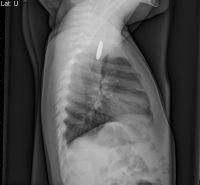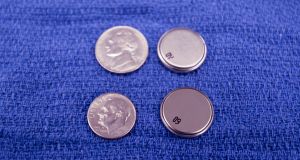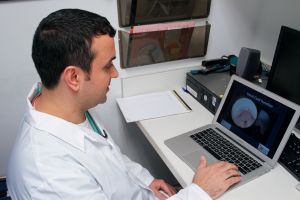With the increasing production of electronic products in the consumer market, more button batteries are found in the home setting. From remote controls and watches to musical greeting cards and toys, these small, shiny objects are the perfect size for a curious child to swallow or even push into their nasal cavity or ear canal. It is important for parents to be aware of the dangers that button batteries pose to young children and the damage that these batteries can cause.
The incidence of button battery ingestion is rising. Between 2007 and 2009, more than 3,400 cases annually were reported to U.S. poison centers. The clinical challenge for physicians who may evaluate children who ingest button batteries is that they can be asymptomatic or present with non-specific symptoms such as irritability, fever, cough, poor oral intake and/or vomiting similar to those of a common viral infection. This, combined with the likelihood of an unwitnessed ingestion event, is the recipe for disaster, leading to a delay in the diagnosis and more severe injury.
“The clock is ticking when a button battery is placed in the body,” said Kris Jatana, MD, a pediatric head and neck surgeon at Nationwide Children’s Hospital. “In as little as two hours, these button batteries can cause severe injury.”
Button batteries, small and large, are dangerous in the hands of a child. While the smaller batteries, such as those found in hearing aids, will typically pass through the gastrointestinal system on their own, the larger batteries can get stuck, causing the most significant injury when swallowed by young children. Some complications from button battery ingestions include eroding through the esophageal wall or into the adjacent airway, damage to the nearby nerves which supply the vocal cords, or even more serious – eroding into a major blood vessel such as the aorta which has always been fatal.
“I have seen many otherwise healthy children suffer serious injury from button batteries,” said Dr. Jatana, also an assistant professor of Otolaryngology-Head and Neck Surgery at The Ohio State University College of Medicine. “While educating parents about the dangers of these batteries is important, it is equally important for physicians to be aware of the increasing frequency of button battery ingestions when evaluating children in the primary care or emergency room setting. An x-ray can be done to confirm the diagnosis.” If a child is suspected of swallowing or pushing a button battery into their nasal cavity or ear canal, the child needs to be taken to an emergency room immediately. The diagnosis can be confirmed by a two view x-ray, which from a distance, may be mistaken for a commonly ingested foreign body in children – a coin. The key to differentiating a button battery from a coin is to magnify or zoom into the image to look for the double ring or halo seen around the button battery. In addition, on the side view x-ray, one can often see a small step-off or notch with most batteries. “Identifying a metallic foreign body as a button battery is critical as the battery creates an electrical current around the outside of the battery generating hydroxide, an alkaline chemical, causing the rapid tissue injury,” said Dr. Jatana.
The treatment for a button battery lodged within the body is emergent removal. When swallowed, these batteries can get lodged in the esophagus which requires general anesthesia for removal in an operating room. When pushed into the ear canal or nasal cavity, the removal can usually take place in an emergency room setting.
On March 17, 2011, Dr. Jatana presented with a panel of experts from across the country to the U.S. Consumer Product Safety Commission (CPSC) in Bethesda, on the hazards of button batteries. Later on that month, the CPSC released a public warning statement emphasizing the dangers of button batteries to consumers. In June, two U.S. senators, Senator John D. Rockefeller and Senator Mark Pryor, introduced new legislation entitled the “Button Cell Battery Safety Act of 2011.” If this legislation passes through Congress, the CPSC would be able to regulate electronic devices that contain these batteries to make them safer for children. “The initiation of this legislative process shows the true commitment of members of U.S. Congress and the CPSC to the safety of children,” said Dr. Jatana.
“Parents need to be aware of this potential household risk to ensure that button batteries themselves, and any electronic devices that do not contain them in a properly secured compartment, are kept out of the reach of young children,” said Dr. Jatana.

The key to differentiating a button battery from a coin is to magnify or zoom into the image looking for a double ring or halo. This x-ray shows a small ridge on the object that this toddler has swallowed – a button battery.

While coins and button batteries look very similar and are of equal size, button batteries can cause severe damage if not removed quickly after it is ingested.

Dr. Kris Jatana presented with a panel of experts to the Consumer Product Safety Commission on the hazards of button batteries.
